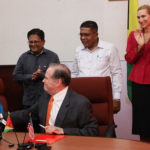Launch of Agriculture Month, National Tree Day and Interfaith Service
Hon. Noel Holder M.P., Minister of Agriculture
Iwokrama International Center for Rainforest Conservation and Development
Saturday October 1, 2016
Mr. Chairman, Your Excellency, President David Granger and Mrs. Sandra Granger, Colleague Ministers, Members of the Diplomatic Corps, special invitees, representatives of religious organisations, ladies and gentlemen, it is a delight to usher in Agriculture Month 2016 with you. I express my heartiest welcome to the second annual National Tree Day and the Annual Interfaith Ceremony of the Ministry of Agriculture.
Guyana has been advocating the sustainable development agenda and is committed to implementing a “Green Development Plan” to guarantee that sustainable development is synonymous with national development. As such, importance must be given to the repercussions that the effects of climate change may have on this developmental path. Therefore, it is vital that we enforce measures to withstand the effects of climate change. Agriculture Month 2016 is being held under the theme, “Exploring new production frontiers: in pursuance of climate resilience.” Guyana is richly endowed with key natural resources – land, fertile soils, water, forests and fisheries – for agricultural development. However, the agriculture sector is prone to climate risks. The theme for 2016 reflects on building a resilient agriculture as a means of adapting to the effects of climate change.
Similarly, National Tree Day 2016 is being held under the theme, “Sustaining Biodiversity: Plant a Tree.” By proclaiming the National Tree Day it is our hope to create more awareness about the importance of all types of trees for food, medicinal purposes, fibres for clothing, wood for shelter, inter alia.
I urge all Guyanese to commit to planting trees, reducing deforestation with the concomitant effects of reducing poverty and promoting sustainable livelihoods for all dependent on trees.
It is noteworthy that the Iwokrama International Center for Rainforest Conservation and Development has been chosen as the site to launch agriculture month and to observe National Tree Day. Over the last 20 years the Iwokrama International Centre (IIC) has managed 371,000 hectares of the Iwokrama rainforest and has contributed to “lasting ecological, economic and social benefits to the people of Guyana and to the world in general”. Iwokrama has been working with partners to develop a new approach to enable countries with rainforests to earn significant income from eco-system services and creative conservation practices.
Building resilience for adaptation to climate change in the agriculture sector
Each country has different risks to be faced. In Guyana, the predicted sea level rise coupled with extremes in rainfall events will increase the frequency and level of flooding in coastal Guyana. Additionally, sea level rise could also affect the supply of fresh water through salt water intrusions into aquifers, threatening domestic and industrial water supplies. There are huge variations between countries, in terms of risks to be faced and capacities to face them. There remain many environmental problems which have over the years increased as a result of human activities and unplanned management of technological development.
The Ministry of Agriculture has adopted a holistic approach, embracing various risks, and accounting for synergies and trade-offs. Indeed, one of the most effective ways for agriculture to adapt to climate change could be to increase its resilience. What we would focus on is the various risk management strategies to deal with such changes; such avenues would be the work plan of the National Drainage and Irrigation Authority, Ministry of Agriculture Flood Risk Management project, and the more recent recommendations of the Kingdom of Netherlands Dutch Risk Reduction (DRR) Team. Together these initiatives will map a holistic approach to dealing with drainage in the flood prone city of Georgetown and its surroundings.
Over the years, the Ministry of Agriculture has been involved in small shifts in the farming model to promote climate resilience. These have been replicated in a number of coastal communities. They include developing water-saving irrigation systems; resistant varieties of crops and breeds of livestock to drought, flood, pests and diseases; the creation of high spots and the empoldering of pastures to minimize livestock mortality and morbidity during flood conditions, regulating fishing to ensure sustainable fishing; and the implementation of other improved management practices.
Hinterland Development as the new production frontier
This government has made the development of the hinterland a priority with the implementation of polices for development of the Rupununi and Intermediate Savannahs- positioning the hinterland as the next frontier for the nation’s agricultural development.
Works are apace to have re-established agricultural stations in each of the main Eco-zones of Guyana. This is being done to nurture integration between the coast and hinterland and to increase access to the bountiful resources of our hinterland. Among the areas stations will be established include:
- North West District: Region 1 – Wauna – Quarantine Station Agriculture
- The Pakaraimas: Region 8 – Kato
- The Rupununi savannahs: Region 9 –at Pirara
- The Intermediate Savannahs: Region 10 – the expansion of the Ebini Agricultural Station
Large scale infrastructural projects are needed to have a significant positive impact on Guyana’s capacity to respond to climate change. Albeit these require more technical and financial resources and in some instances assistance from outside sources, for example, from international aid organizations.
The Ministry of Agriculture will be involved in transformational projects to tackle climate change. Our Hinterland Development Plan will see us shifting focus on agriculture to the hinterland regions. One of these is water catchment and rain water harvesting in North and Central Rupununi; some possible areas we are looking at include Manari, Annai, Massara,Rupertee, Aranaputa, Toka, Nappi, Parishara.
Private sector’s confidence in the economy has also been proven with the commencement of large scale agriculture in the savannahs with the production of Soybeans, corn and cattle by Brazilian company New Frontier Agriculture Inc. in the Kimbia/Ebini savannahs.
Ladies and gentlemen, these initiatives will create new employment opportunities, both directly, and more so, indirectly as the country’s economic base is moved inland and will complement other activities such as mining, forestry and support service activities thereto appertaining
Everyone has a role to play
In mitigating these effects, everyone has a role to play. Yes, we all know there is a need to sustainably increase production. However, we also need to be conscientious consumers, by reviewing and reducing food losses in our everyday lives. In the world, approximately one third of all food produced is wasted; here is definitely an area in which we can reduce our environmental footprint and make a difference. As government, we will work with farmers and retailers from harvesting, through storage, to transporting and marketing. But wastage also most frequently occurs inside our homes. Many small initiatives can bring about this change.
I also wish to reiterate our Government’s commitment to sustaining food security. One of our main priorities is ensuring that Guyana is on par with the objectives of the Sustainable Development Goals (SDG) especially Goal 2 – Zero Hunger. The Ministry of Agriculture takes this opportunity to encourage all members of society to undertake actions aimed at eating what we produce and to let our citizens know that leading an active, healthy lifestyle starts with the right diet.
Words from the Bible
Lastly, as our Inter-faith service this year will be amalgamated with National Tree Day and the Launch of Agriculture Month activities on this 1st day of October, I would like to thank the Representatives of the Christian, Hindu and Islamic communities for their spiritual words and sentiments expressed to all those present. Today, I would like to complement their teachings by sharing the Old Testimony verse found in the Book of Genesis 1:29,
“And God said, Behold, I have given you every plant yielding seed that is on the face of all the earth, and every tree with seed in its fruit. You shall have them for food.”
I have chosen this verse since I believe it tells us that God has given us all we need to be productive – the land, the sun, the ability. It is there, all we have to do is explore, exploit and develop it. The opportunities are there, it is up to us to take the next step.
In recognition of the numerous challenges facing the sector, a comprehensive approach will be taken in which various issues can be specifically targeted. This year’s celebration will feature several activities which will not only position Guyana to push for more environmentally friendly initiatives such as our National Tree Day, but also target climate resilience approaches for rice, sugar, livestock and agro-processing and other crops. As the month long observances continue, various agencies will show how important agriculture is to our economy. We will also place emphasis on our farmers and the sterling contribution they have made over the years to the nation’s wellbeing.
In conclusion, I wish to thank you for your time and participation as we launch agriculture month 2016 and celebrate National Tree Day. Do continue to join in the Agriculture Month celebrations.
NHL
October 1, 2016





